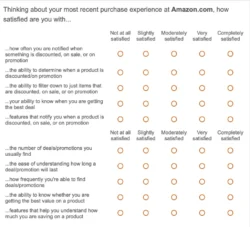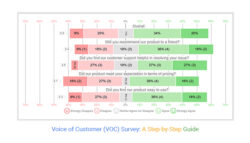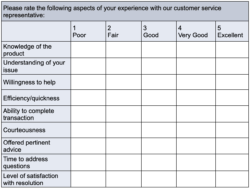Understanding what your customers truly think and feel about your products or services is not just good business practice; it’s essential for survival and growth in today’s competitive landscape. Satisfied customers become loyal advocates, and their feedback is a goldmine for innovation and improvement. But how do you effectively gather this crucial information without overwhelming your customers or your team? The answer often lies in a well-crafted, easy-to-use online survey.
Online surveys offer a streamlined, efficient, and scalable way to collect insights from a large audience. They eliminate the need for manual data entry, reduce costs, and allow for quick analysis of results. The beauty of a pre-designed online customer satisfaction survey template is that it gives you a powerful starting point, saving you time and ensuring you ask the right questions to get actionable data.
Crafting an Effective Online Customer Satisfaction Survey
When you set out to measure customer sentiment, simply throwing a few questions together won’t cut it. An effective online customer satisfaction survey template is meticulously designed to capture specific insights, be easy for respondents to complete, and provide you with data that translates directly into business improvements. It’s about balance: getting enough information without causing survey fatigue. Think about what specific actions you want to take based on the feedback before you even start writing questions. Are you looking to improve a product feature, refine your customer service process, or understand overall brand perception? Your goals will shape your questions.
The flow and length of your survey are also critical. Most customers are short on time, so a concise survey that respects their busy schedules is more likely to be completed. Start with general questions and move to more specific ones. Avoid jargon or overly technical language that might confuse respondents. Every question should have a clear purpose, contributing to your overarching goal of understanding customer satisfaction. Remember, a poorly designed survey can frustrate customers and yield unreliable data, which is worse than no data at all.
Key Elements and Question Types
An excellent online customer satisfaction survey template incorporates a mix of question types to capture both quantitative and qualitative data. This blend provides a comprehensive view of customer sentiment, allowing you to see the bigger picture through numbers and dive into the specifics through open-ended comments.
* Net Promoter Score (NPS) Question: “On a scale of 0-10, how likely are you to recommend [Your Company/Product/Service] to a friend or colleague?” This single question is powerful for gauging overall loyalty.
* Customer Satisfaction (CSAT) Question: “How satisfied are you with [specific product/service/interaction]?” Typically rated on a scale (e.g., 1-5, Very Satisfied to Very Dissatisfied). Great for transactional feedback.
* Customer Effort Score (CES) Question: “How easy was it to [perform a specific task, e.g., resolve your issue, find information on our website]?” Measures the ease of interaction with your business.
* Likert Scale Questions: Used to gauge agreement or disagreement with statements, or the frequency of certain behaviors. For example, “I found the website easy to navigate” (Strongly Agree to Strongly Disagree).
* Open-ended Questions: Provide space for customers to elaborate on their experiences. Questions like “What could we do to improve?” or “Is there anything else you would like to tell us?” offer invaluable qualitative insights.
The choice of questions will depend entirely on what aspects of the customer journey you want to evaluate. By using a variety, you get a richer dataset to analyze.
Putting Your Customer Feedback to Work
Gathering feedback through an online customer satisfaction survey template is just the first step; the real value comes from what you do with the insights. Once you’ve collected the responses, dive into the data. Look for trends, common themes in open-ended responses, and identify areas where your performance consistently excels or falls short. Are there specific products getting rave reviews? Is there a recurring complaint about a particular service channel? Data visualization tools within your survey platform can be incredibly helpful here, turning raw numbers into easily digestible charts and graphs.
Don’t just analyze the data in a silo. Share the findings across relevant departments. Customer service, product development, marketing, and sales teams can all benefit from understanding what customers are saying. This shared knowledge fosters a customer-centric culture within your organization, ensuring everyone is aligned on the common goal of improving the customer experience. When different teams see the direct impact of their work on customer satisfaction, it empowers them to make more informed decisions.
The most crucial part is taking action based on the feedback. If customers consistently highlight a certain pain point, prioritize addressing it. Whether it’s a bug in your software, a confusing part of your website, or an issue with your delivery process, showing that you listen and respond builds trust and strengthens customer loyalty. Small improvements, consistently implemented, can lead to significant gains in customer satisfaction over time. Remember, the survey is a tool for continuous improvement, not a one-time event.
* Regularly Review: Set a schedule to review survey results, whether monthly, quarterly, or after specific interactions.
* Identify Key Trends: Look beyond individual comments for recurring themes and patterns in the data.
* Prioritize Actions: Based on the trends, decide which issues are most critical to address first.
* Communicate Changes: If appropriate, inform customers about the improvements you’ve made based on their feedback. This reinforces that their voice matters.
* Close the Loop: For specific customer complaints, consider reaching out directly to resolve their issue, turning a negative experience into a positive one.
By following these steps, you transform raw data into actionable strategies that genuinely enhance your customer relationships and drive business success.
The insights gleaned from a well-executed customer satisfaction survey are invaluable, providing a direct line to the hearts and minds of those who matter most to your business. It’s about building a continuous loop of listening, learning, and improving, fostering stronger relationships and ensuring your offerings genuinely meet market needs.
Embracing the power of customer feedback is not just about problem-solving; it’s about identifying new opportunities for innovation and growth. By consistently engaging with your customers and acting on their input, you pave the way for sustained success and create a loyal customer base that champions your brand.


